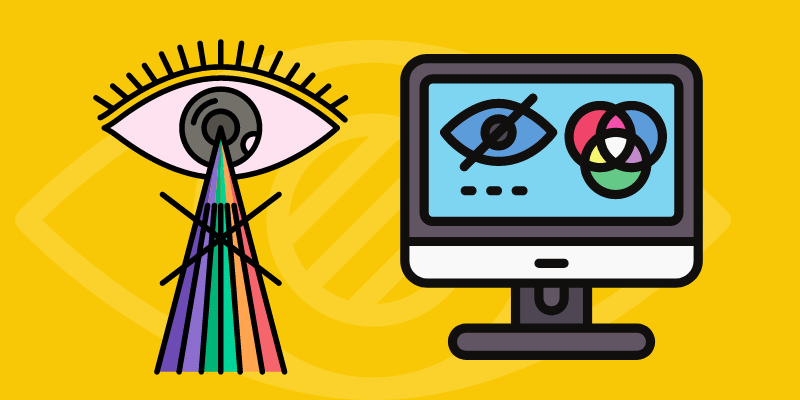Color blindness, also often referred to as daltonism. Actually is a vision disorder that manifests itself as the inability to see and distinguish between a specific colors. This vision disorder is rare in women, but occurs in about one in twelve men. In percentage terms, 8-10% of men and 0.5% of women have some form of color blindness. For comparison, out of every 100 website visitors, approximately 10 visitors can see colors differently.

A little about color blindness
People who have color blindness clearly see the same objects as people who do not have this disorder. The main difference is the inability to distinguish between red, green, or blue. Sometimes the ability to perceive yellow disappears. The least common type of color blindness is monochrome color blindness or complete inability to distinguish colors. That is, a person cannot distinguish any color and sees the world in black and white. In turn, the most common is the inability to perceive green and red colors. As well as shades that contain elements of these colors (for example, purple shades).
Why is it necessary to adapt the design of a website for people with color blindness?
Of course, many may wonder why it is necessary to make changes to the website for such a small group of people who have this feature. Firstly, making improvements to the website will definitely improve the experience of all users. Including those who do not suffer from color blindness. In addition, developing a website that is easy to use and accessible to everyone allows you to comply with the best practices of web design. When creating or improving your website, ecommerce web design Dubai are recommend to apply a number of basic conditions so that its design is friendly also for users with color blindness.
1. Choose a minimalist style for color blindness
A minimalist website is not only following the latest trends in web design, but also a useful tool that helps to distinguish colors. In recent years, ecommerce website development Dubai has also adopted the use of as simple a design as possible to help the user perceive the information better. When adapting or creating your site based on the principles of minimalism, get rid of too much color variety. The fewer colors in the page design, the better the interface will be perceived by people with color blindness. In this case, both sides win – people who are not color blind will also find it easier to perceive your website.
2. Use graphic symbols
Of course, using colors on websites is a common practice, but we cannot recommend to rely on them alone. For example, everyone is familiar with the situation when errors or other notifications on a website that we can see in red. However, people who have a form of color blindness that does not allow them to distinguish the color red will most likely not be able to identify this notification or error. In such cases, ecommerce website Dubai recommend to supplement the error notification with some graphic symbol or relevant text to attract the user’s attention.
The same applies to other colors on the website. People with impaired green and red colour perception will be able to correctly identify approximately 5 colours of crayons from a set of 24 colours. Therefore, it is recommended to supplement the most important notifications/elements with an icon or other graphic symbol, drawing or corresponding description.
3. Use some colors that very contrast
The contrast of white and black is not the only way to improve the experience of color-blind users. Use different, clearly contrasting colors to highlight text or menu options that you need. Internal links or other important units are often highlighted in a different color.
4. Beware of certain color combinations
Although the previous point gave advice on using contrasting colors, not all color combinations are color-blind friendly. In order to choose the right combinations, it is necessary to understand the essence of colors, the features of the spectrum. There are a number of combinations that people are NOT recommend for use in web design if you want to adapt it to people with special perception of colors.
5. Add texture and patterns to website elements
In order to highlight different elements of the site. Which is recommend to use contrasting patterns or textures instead of single-color elements. Users who are color blind often have difficulty perceiving various charts, such as bar charts, so-called pie charts, etc. If charts and graphs play an important role on your website. We can recommend to use contrasting textures to display them in order to be able to distinguish the results. This is especially important in cases where a small number of colors that people usually use in the website design. But it is important not to get too carried away with textures, because many users may find this inappropriate.
Developing a website design that is accessible to everyone generally does not require a lot of time. The final product can be conveniently used by both color blind people and those who do not have this vision feature. If you also want to create a website that everyone can use. Contact our developers and we will offer you the most suitable solution.


